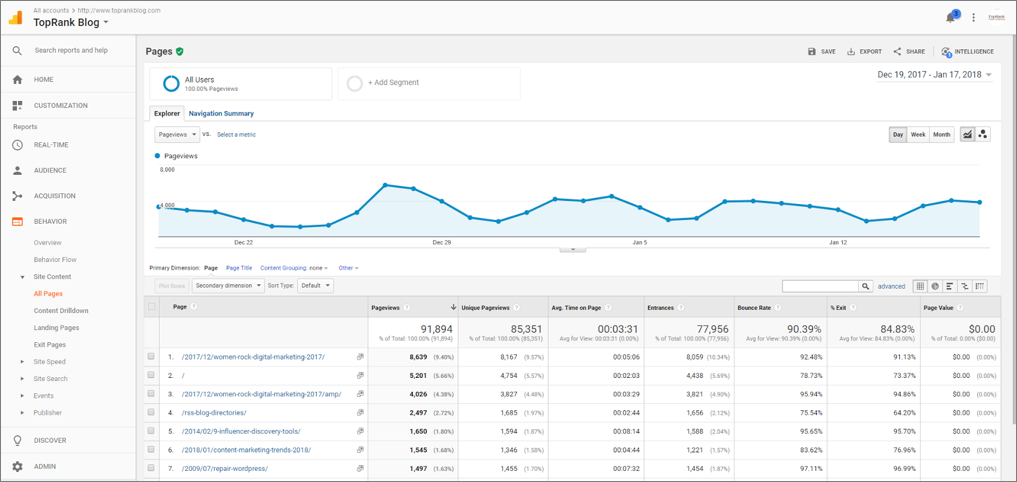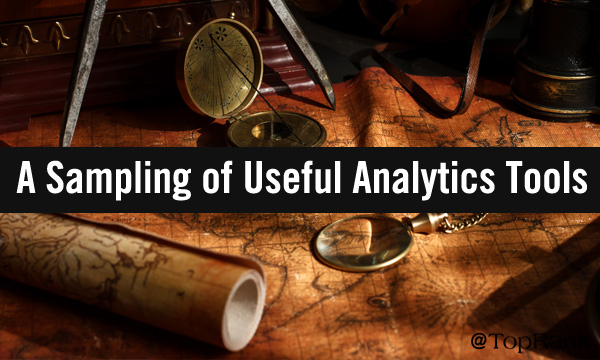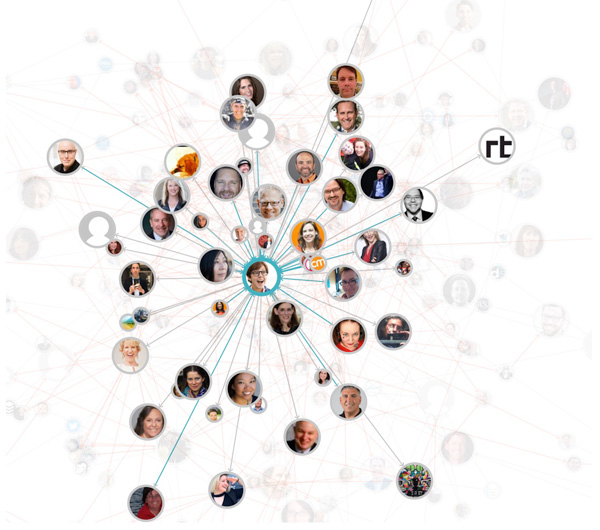Measuring Content Marketing Success: Analytics Advice & Insight from the Experts

 Welcome to the seventh installment in our “Collective Wisdom” series of content marketing strategy and tactics articles. Previously we’ve covered planning ahead for content marketing success, the art of crafting powerful content, and an array of strong promotion tactics. So, what’s up next? Measurement and analytics. Measuring and analyzing your content’s performance is critical so you can uncover new opportunities, make improvements, and determine whether you’re meeting your goals. Here we share some tidbits of analytics wisdom and insights from some famous figures inside and outside the digital marketing realm.
Welcome to the seventh installment in our “Collective Wisdom” series of content marketing strategy and tactics articles. Previously we’ve covered planning ahead for content marketing success, the art of crafting powerful content, and an array of strong promotion tactics. So, what’s up next? Measurement and analytics. Measuring and analyzing your content’s performance is critical so you can uncover new opportunities, make improvements, and determine whether you’re meeting your goals. Here we share some tidbits of analytics wisdom and insights from some famous figures inside and outside the digital marketing realm.
Having the Right Data is Crucial for Measuring Success
How do you gauge success in content marketing? At the most basic level, you want to learn how much online traffic is coming to see your content. But what should you count and what can be ignored? Albert Einstein offered insight that I think applies to marketing analytics, and on a greater scale to life itself. [bctt tweet="“Not everything that can be counted counts, and not everything that counts can be counted.” — Albert Einstein" username="toprank"] via GIPHY Measuring this traffic has always been rather tricky, and nearly as long as the Web has been around there have been tools dedicated to helping track and understand just how successful a piece of content is. Even as we've seen the growth of big data, extracting the right information is still a challenge, as Tamara McCleary, CEO at Thulium.co, points out. [bctt tweet="“Everyone likes to talk about Big Data. The truth is, what we really need is Smart Data.” @TamaraMcCleary " username="toprank"] Regardless of your industry, there's no sure-fire substitute for common sense, as digital transformation speaker and Forbes contributor Daniel Newman has noted. [bctt tweet="“While I do love big data, I know there is no substitute for good old-fashioned common sense. If the data really doesn’t fit, question it. Ask deeper questions.” — Daniel Newman @danielnewmanUV" username="toprank"] Besides server-based software, hundreds of companies also offer specialized Web analytics tools that operate using remote access to your content, the most popular of these being Google Analytics. Here's an image of Google Analytics from "How to Prove the Value of Content Marketing to Your CMO in 3 Easy Steps," by our own Content Strategist Anne Leuman. No matter which software, online tool, or service you use, the pursuit is by its very nature a complex one. It requires a good deal of dedication and learning to deeply understand which bits of data you really care about, so you can find the best ways to accurately gather and analyze them.
No matter which software, online tool, or service you use, the pursuit is by its very nature a complex one. It requires a good deal of dedication and learning to deeply understand which bits of data you really care about, so you can find the best ways to accurately gather and analyze them.
Choosing The Right Analytics KPIs
No matter which tools you choose, a primary decision you’ll have to make is what to measure to gauge success of failure, and these will be your Key Performance Indicators (KPIs) — those signals that matter the most to you and your business. KPIs vary widely, so it’s important to find the ones that will provide you with the data that’s the most relevant to your own content measurement situation. Setting S.M.A.R.T. goals — those that are Specific, Measurable, Attainable, Relevant, and Time-Based — are especially pertinent in the realm of data analytics, as Danica Benson, Global Product Marketing Manager SMB at SAP Concur and former Marketing Communications Manager at Rival IQ, has pointed out. [bctt tweet="“Digital marketing analytics software can aggregate and report on a wide array of metrics, many of which are fun to know, but without context don’t tell you much about how to move forward.” — Danica Benson" username="toprank"] The dangers of relying too heavily on statistics, however, have been espoused for over 100 years, including the famous quote popularized by Mark Twain in 1906, “There are lies, damned lies, and statistics.” Knowing how to wisely interpret statistical data — especially what information to set aside — is a bit of a combination of art and science that takes dedication and research. via GIPHY Jay Acunzo, founder, host and writer at Unthinkable Media, explores two methods of finding this data measurement wisdom in “There Are 2 Ways to Approach Data. Which Helps vs. Hurts Creativity?,” offering both an Aristotelian and a Galilean take on the art and science. [bctt tweet="“When we’re data informed, we isolate variables, test, and learn. We insert our own sense of taste and our intuition into the process.” @jayacunzo" username="toprank"] Taking the time to learn and choose the right KPIs for extracting actionable insight from your analytics data is well worth the effort, as Kyle Harper, Marketing Analyst at Harvard University points out in his recent "Comprehensive Guide to Connecting Content Marketing KPIs to Business Goals." [bctt tweet="“Well-chosen content marketing KPIs are more essential than ever. Knowing the right KPIs to track can help sort out the most important performance information from the noise.” — Kyle Harper @TheyWereFlying" username="toprank"]Analytics Can't Simply Be an Afterthought
Deciding how to measure success is critical to any content marketing strategy, so measurement and analytics need to be included from the very beginning of your planning process. Large numbers of technical professionals worldwide make a career from trying to gauge the success of online content. And while it isn’t our intent to teach you the detailed and ever-changing intricacies of analytics, we would like to share some fundamental truths with you. Longtime technology consultant Joel Snyder, Ph.D. points out in a recent article that analytics is far from new, and that even the smallest firms now gather heaps of statistical data. [bctt tweet="“Data analytics isn’t some new magic bullet. It’s a way of leveraging the data that most every business has been quietly accumulating for years to deliver insights that lead to better decisions.” — Joel Snyder, Ph.D. @joelsnyder" username="toprank"] In some ways, some aspects of analytics have gotten easier. With the massive growth of the internet at-large, social media, and other platforms, methods for tracking that have become nearly universal—such as the ubiquitous Facebook "like" or Twitter "heart." via GIPHY Whether you’re just starting out or a seasoned pro, a considerable challenge is wading through the vast number of analytics tools and finding the ones that mesh well with your needs, including how you prefer to visually see your analytics data. Some tools offer only simple text-based lists, while most make a point to present analytics information in ways that are visually easier to understand. Using just one analytics utility was commonplace in the Web’s early year. But today, it’s not unusual for savvy digital marketers to use five, 10, or even more tools, all from different firms — some free, some commercial, and others custom-made. Accurate and relevant measurement can also help with influencer marketing campaigns, as our CEO Lee Odden looks at in “B2B Marketers: Is Your Influencer Marketing Mechanical or Meaningful?” [bctt tweet="“Platforms like Traackr, Onalytica, GroupHigh and BuzzSumo (to name a few) can be instrumental for the most effective (vs. subjective) influencer identification, engagement, measurement and program management.” @LeeOdden" username="toprank"]Analytics Tools Can Be Your Best Friend
 The scope and complexity of analytics tools varies greatly, but where can you start when looking to begin a new campaign, or when you just want to keep up on the new players that are entering the market in greater numbers than ever? To help you learn more about some of the analytics tools available, we've put together a list of 11 helpful resources exploring several of the more popular analytics tools and services. Four Takes On Google Analytics
The scope and complexity of analytics tools varies greatly, but where can you start when looking to begin a new campaign, or when you just want to keep up on the new players that are entering the market in greater numbers than ever? To help you learn more about some of the analytics tools available, we've put together a list of 11 helpful resources exploring several of the more popular analytics tools and services. Four Takes On Google Analytics
- In “6 Ways Content Marketers Can Get More Value From Google Analytics,” Jessica Greene, a writer at JeffBullas.com, takes a look at how to turn on a number of helpful Google Analytics features that are off by default, with plenty of screen shots and tips.
- Andy Crestodina, Co-Founder of Orbit Media, has put together a helpful guide to setting up Google Analytics in his recently-released “How to Set Up Google Analytics: The Complete Guide (with video).”
- With his recent “How to Track Awareness, Completion, and Engagement Goals With Google Analytics,” marketer Chris Mercer examines the process of defining relevant engagement goals using Google’s tools.
- In “Ways to Use Google Analytics for Content Ideation [Infographic],” Jomer Gregorio, CEO at Digital Marketing Philippines, shows some of the ways that Google Analytics can also be used in the creative process.
- SEMrush is a popular research and analytics service, and its “Practical Guide to Data-Driven Content Marketing,” is a good introduction to many of the tools the company offers, including the Content Toolkit.
- Trust Insights has provided fascinating and useful influencer graphs at several of the events TopRank Marketing has spoken at in 2018. In his recent "50 B2B Marketing Influencers and Experts to Follow Into 2019," Christopher Penn, co-founder of Trust Insights, shares his 2019 trends video post on LinkedIn.
 Ahrefs
Ahrefs
- Sometimes the amount of information available from an analytics tool can be overwhelming. However, for those using the popular Ahrefs service, company Chief Marketing Officer Tim Soulo looks at many of the helpful pieces of data at hand in “Ahrefs’ SEO Metrics: What They Mean and How to Use Them.”
- Quintly, which began in 2010, has increased the number of tools it offers over the years, and in “(This is) Why you need professional social media analytics for your business!,” industry speaker Lilach Bullock takes a look at some of the unique features the service provides.
- Twitter’s own metrics can provide helpful insight, and in “6 Twitter Metrics to Follow to Boost Your Online Presence,” Brand24 — maker of its own social media monitoring tools — takes a look.
- Facebook offers a huge array or analytics features, and in “How to Use Event Tracking in Facebook Analytics: Event Source Groups,” Amy Hayward of Social Media Examiner gives a helpful rundown of some of the latest Facebook tools.
- BuzzSumo has grown to become a go-to analytics tool for many digital marketers, and in “How To Find The Best B2B Content With BuzzSumo’s Business Filter,” Steve Rayson, former Director at BuzzSumo, takes a look.
Additional Resources to Put You on the Path to Informed Measurement
 As a final parting bonus list, here’s a collection of recent helpful additional resources to boost your analytics knowledge.
As a final parting bonus list, here’s a collection of recent helpful additional resources to boost your analytics knowledge.
7 Recent Data Analytics Trends
- What happens when trust in platform metrics is eroded? “Facebook missteps highlight what happens when you can’t trust platform metrics,” written by Amy Gesenhues of Marketing Land, digs in and explores the challenges.
- Our own Alexis Hall, Vice President of Client Accounts, shines light on “5 Common Digital Marketing Data & Analytics Challenges and How to Start Solving Them.”
- “Why Your Business Needs to Pay Attention to Its Social Media Analytics, from Day One,” by Paul Herrera of MarTechSeries, offers another take on the increasing importance of social media data.
- Christoph Trappe, Chief Content Engagement Director at Stamats Communications, takes a look at whether you can have too many analytics tools in your strategy, with “[MEASURING RESULTS] How many web analytics services should I use on my website?”
- 10 Tools to Monitor Brand Mentions [Social Media Monitoring Tools] by Influencer Marketing Hub looks at some of the tools we’ve mentioned, along with several others worth checking out.
- Visualizing the data you’ve carefully extracted in a way that can be easily understood and put in perspective is an important part of analytics. Maria Popova of Brain Pickings has several fine examples of data visualization in her recent “The Original Manifesto for Information Visualization and Pictorial Statistics: ISOTYPE Creator Otto Neurath’s Pioneering 1930 Visual Language.”
- Concluding our list is “What Great Data Analysts Do — and Why Every Organization Needs Them,” by Google data scientist Cassie Kozyrkov for the Harvard Business Review, who offers a fascinating in-depth look at how top data analysts achieve success.
Next Up: More Measurement Tactics For Your Campaigns
By learning the fundamentals of data analytics, choosing the tools that best fit your own particular needs, and keeping up on the latest industry news, your content marketing will be set to have measurable advantages over those who skip or only pay lip service to the art of metrics. Next up in our “Collective Wisdom” series we’ll take a look at additional measurement and analytics tools and how to use the data you gather. If you haven’t yet caught our previous episodes in this series, hop back and study up:- “How to Boost Your Content Marketing Efforts By Planning Ahead”
- “The Art Of Crafting More Powerful Content: 5 Top Tactics from the Experts”
- “5 Powerful Messaging Tactics For 2019 And Beyond From Marketing Experts”
- “Don’t Blink: 3 Often-Overlooked Practices for Highly-Effective Content Creation”
- “Step Right Up! 8 Content Promotion Showstoppers For 2019“
- “Spicy Twists and Tactics For Unique Content Promotion”
The post Measuring Content Marketing Success: Analytics Advice & Insight from the Experts appeared first on Online Marketing Blog - TopRank®.
Measuring Content Marketing Success: Analytics Advice & Insight from the Experts posted first on http://www.toprankblog.com/
Comments
Post a Comment